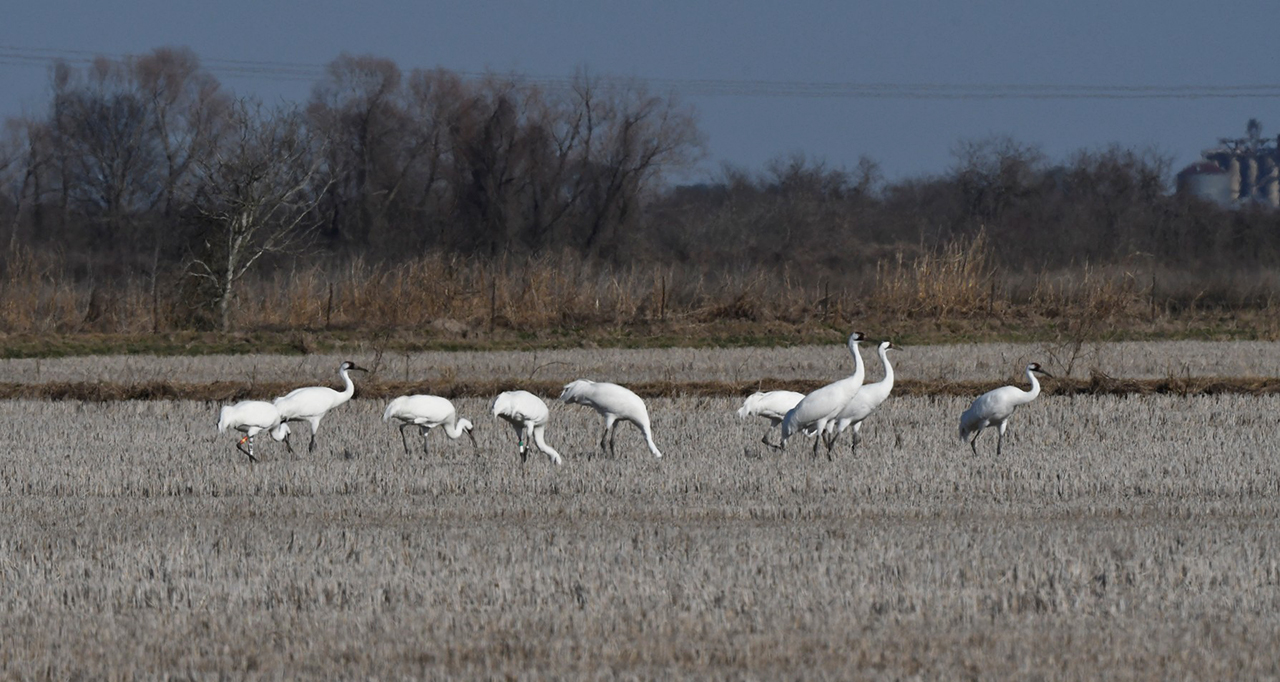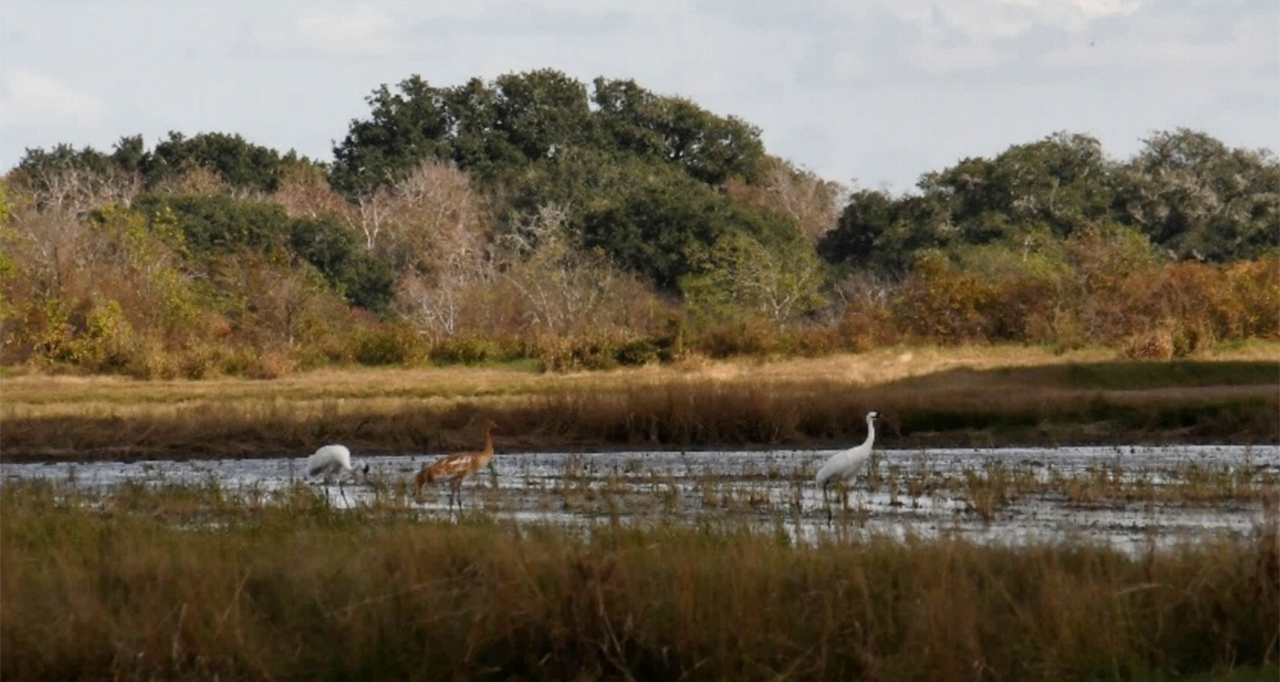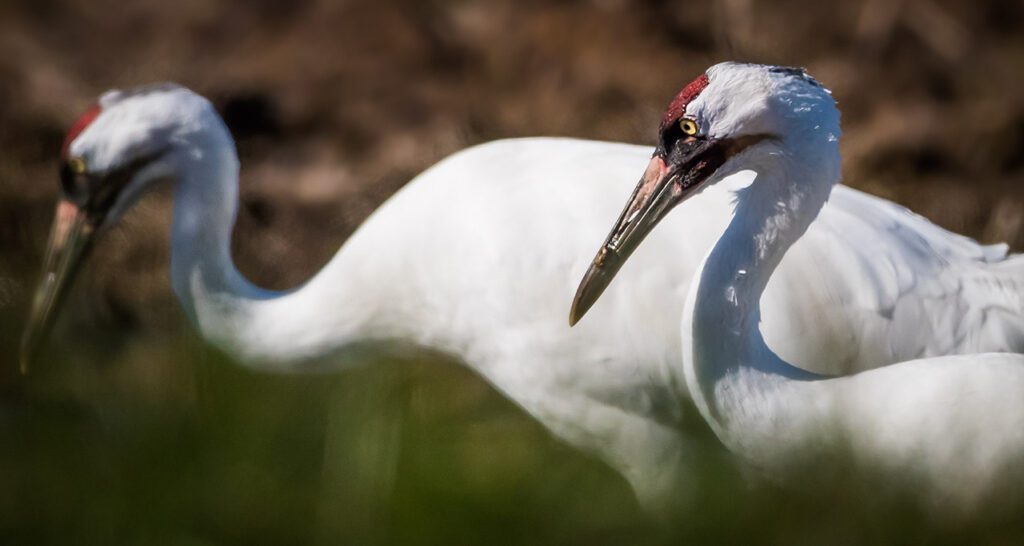Inland Wintering Whooping Cranes in the Aransas-Wood Buffalo Population

A group of nine Whooping Cranes forages in a recently harvested rice field in Colorado County, Texas. Matti Bradshaw/International Crane Foundation
For over 70 years, scientists and conservationists have come to understand the habitat needs of the Aransas-Wood Buffalo Population of Whooping Cranes. The last self-sustaining population relies heavily on estuarine habitats of the Texas Mid-coast during the winter, where they eat blue crabs, Carolina wolfberries, mollusks, and other food items. This habitat blueprint has determined how the conservation community prioritizes land protection and habitat management in the current and expected future wintering range of the population. However, Whooping Cranes continue to surprise us, and they are increasingly using habitat away from the coast.
Researchers from the International Crane Foundation, the United States Fish and Wildlife Service, and a local volunteer, initiated research to better understand the phenomenon of inland wintering in the population.
First, we summarized how many winters Whooping Cranes utilized two prominent inland wintering sites. In a thirteen-year period starting in the winter of 2011/2012, Whooping Cranes spent five winters on or near Granger Lake and eleven winters in Colorado and Wharton counties. Both areas are dominated by agriculture, which is a common habitat type used on migration by Whooping Cranes. The surrounding area near Granger Lake is dominated by wheat, cotton, and grain, while Colorado/Wharton counties are dominated by rice agriculture. Next, the researchers presented information on the number of individuals using these two inland wintering areas. While use near Granger Lake declined after the first few years of use, in Colorado/Wharton counties the number of Whooping Cranes identified has been steadily increasing. Up to 18 individuals were recorded using this area in the winter of 2023/2024. We documented at least 21 individuals using Colorado/Wharton counties in the winter following publication of our findings.

Family of Whooping Cranes in Colorado County foraging in flooded field. Katie Fernald/International Crane Foundation
To better understand inland wintering Whooping Cranes, the team then compared home ranges and daily movement data on both inland wintering individuals and those in more traditional coastal habitats. We found that home range sizes of Whooping Cranes that utilized inland areas were around three times larger than those using coastal areas exclusively. While other factors were found to influence daily movement, birds that utilized inland areas moved almost twice as much during a given day than their coastal counterparts.
These differences may be explained by several factors related to resource availability and social dynamics with other Whooping Cranes. Food distribution, quantity, or quality may differ between inland wintering areas and coastal areas. Movement rates in inland wintering areas may also differ due to lower crane densities and fewer territorial disputes. However, we noted that all the cranes that utilized inland areas visited the coast at least once during the winter. These inland wintering individuals moved more than coastal birds both while they were in inland areas and when they visited the coast. So, some of the observed differences could be as related to the birds as they are to habitat differences.
This research highlights a temporary or permanent shift or expansion of the population’s wintering range, and the researchers pointed out that, “Continued use of inland areas has implications for how we manage, monitor, and plan for this population’s recovery.” There is more work to be done to understand these inland wintering Whooping Cranes, so the team plans to continue data collection on these inland wintering birds in the coming years.
References:
Crouch, C. G., A. J. Caven, M. R. Bradshaw, K. M. Fernald, M. J. Butler, and M. A. Kalisek. 2024. Space use and movements of inland wintering Whooping Cranes in the Aransas-Wood Buffalo population. Avian Conservation and Ecology 19(2):16.
Story submitted by Matti Bradshaw, Leiden Conservation Whooping Crane Biologist, and Dr. Carter Crouch, Director of Gulf Coast Programs.


